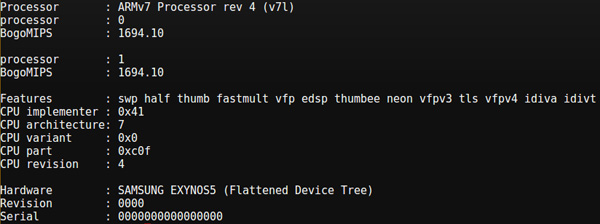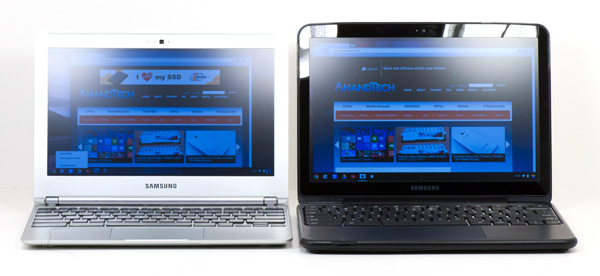Samsung Chromebook (XE303) Review: Testing ARM's Cortex A15
by Anand Lal Shimpi on October 31, 2012 9:00 AM ESTPerformance: Atom vs. ARM's Cortex A15
In our iPhone 5 review I included this crude diagram comparing the high level micro-architecture layouts of the current crop of mobile CPU cores. While most of the cores looked fairly similar, the one to really stand out is ARM's Cortex A15. A three issue, OoO core, the Cortex A15 was designed to put ARM in a completely new performance category.

For 2013, the Cortex A15 is expected to be the ARM CPU core of choice for the next wave of smartphone and tablet SoCs. NVIDIA's Wayne should integrate multiple Cortex A15s as well as competing solutions from Samsung and TI. Samsung's Exynos 5 Dual, found in the new Chromebook, integrates two ARM Cortex A15 cores running at 1.7GHz. As our first experience with a Cortex A15, I wanted to get a good idea for how it would compare to Intel's Atom. And now me comparing to the older Chromebook 500 makes sense. The Atom N570 in the older Chromebook is the closest approximation we have to the currently shipping Atom based mobile SoCs. There are a number of enhancements to the newer chips (particularly when it comes to power consumption), but the base core is very similar. It's clear that the Sandy Bridge Celeron based Chromebook is faster than this new Cortex A15 design, but how about the old dual-core Atom model?

As Chrome OS is built around the Chrome browser, our tests had to be largely JavaScript based unfortunately. The good news is that even given the nature of the benchmarks, we're able to get a good feel for performance between the two SoC platforms. Both systems were running the latest version of Chrome OS at the time of publishing.
| Samsung Chromebook Performance Comparison | ||||||
| SunSpider 0.9.1 | BrowserMark | RIABench Focus Tests | Kraken | |||
| Atom N570 1.66GHz | 1034.3 ms | 152780 | 1968 ms | 14229.5 ms | ||
| Exynos 5 Dual 1.7GHz | 690.5 ms | 217031 | 1192 ms | 9733.2 ms | ||
The Cortex A15 is fast. Across the board we're seeing a 40 - 65% increase in performance over a dual-core Atom. Although it's not clear how performance will be impacted as companies work to stick Cortex A15 based SoCs in smartphones with tighter power/thermal budgets, in notebooks (and perhaps even tablets) the Cortex A15 looks capable of delivering a good 1 - 2 generation boost over Intel's original Atom core.
The IE10 browser tests tend to agree with our JavaScript performance tests, although the CSS Maze Solver benchmark shows a huge advantage for ARM over Intel's Atom here.
| Samsung Chromebook Performance Comparison | ||||||
| IE10 Bubbles Test | IE10 Fishbowl | IE10 Maze Solver | ||||
| Atom N570 1.66GHz | 11 fps | 5 fps | 45 seconds | |||
| Exynos 5 Dual 1.7GHz | 17 fps | 8 fps | 17 seconds | |||
GPU performance is an even bigger advantage for the Exynos 5 Dual over Intel's old Atom N570 (GMA-3150 GPU). I ran three different webGL tests, each of which showed just how bad the old Atom GPU core was.
| Samsung Chromebook GPU Performance Comparison | ||||||
| WebGL Solar System | WebGL Cubes (500) | WebGL Aquarium (50) | ||||
| Atom N570 1.66GHz | 2 fps | 10 fps | 2 fps | |||
| Exynos 5 Dual 1.7GHz | 22 fps | 28 fps | 38 fps | |||
This comparison isn't really all that fair as the newer Atom cores use Imagination GPUs, although even then they are using relatively underpowered solutions compared to what Samsung is shipping on the Exynos 5 Dual.
The more relevant conclusions here apply to the CPU comparison. Next year Intel is expected to introduce its first new Atom core since the platform's introduction five years ago. The new architecture will bring an Out of Order execution core as well as a tangible performance increase. The question is whether or not this will be enough to fend off advances from Cortex A15 based designs.

The new Chromebook (left) vs. the old Atom based Chromebook (right)
In our Surface review I looked at Clovertrail Windows 8 tablet performance and put it a good 40%+ faster than NVIDIA's Tegra 3. If ARM's Cortex A15 is able to outperform Clovertrail by a similar margin, it could make the next generation of Windows RT tablets even more attractive. Keep in mind that we're looking at an older Atom platform here and not Clovertrail, so the performance deltas could shrink a bit.











149 Comments
View All Comments
superflex - Wednesday, October 31, 2012 - link
Way to use the crappiest pictures of the display you could wrestle up.If the display is on par with other 768 TN panels used in laptops reviewed by AT, why did you use those washed out pictures of the display? I don't see the same lack of photography skills when reviewing other laptops with similar panels.
I guess since Google isn't stroking AT the same way Apple does, a fair review with fair pictures would be pointless.
Hacks!
PsychoPif - Wednesday, October 31, 2012 - link
Why would you base your opinion on a picture when they provide numerics to back up the review?Since I learned about Photoshop, I no longuer believe what I see on a picture anyway.
superflex - Wednesday, October 31, 2012 - link
Ever hear the phrase "A picture says a thousand words"?For the casual viewer, who may not delve into the display numbers, the pictures certainly do tell a story. It just depends on what story AT wants to tell.
superflex - Wednesday, October 31, 2012 - link
Look at the review of the Dell XPS 14Z. According to the numbers in this review, the panel in the Sammy CB is on par, if not better than the one used by Dell. Look at the pictures of the Dell display vs the CB display. Are they on par with one another?You can certainly influence a consumers purchasing decision based on some sub-par photographs.
Well done AT.
PeteH - Wednesday, October 31, 2012 - link
Do you really think the people technologically sophisticated enough to be interested in an AnandTech review are the same people who would base their purchasing decision on one photograph of a display?superflex - Wednesday, October 31, 2012 - link
Do you really think nobody will do a Google search for "Samsung Chromebook Review" and find AT's site on the list?I guess Google is smart enough to know a persons IQ and direct them away from AT and its "sophisticated" readers.
Sheeesh, get over yourself.
PeteH - Wednesday, October 31, 2012 - link
Seriously? Just start reading the review, it is clearly not targeted at consumers. Heck, there's a photo of a circuit board on the first page! There's a tear down of the device (complete with photos) before the display is even discussed! Who is going to read this review other than people who care deeply about the technical aspects of the Chromebook?But I'm starting to think you know that, and the real reason you're upset is because AnandTech pointed out that the Chromebook has a crappy display.
SND_ - Wednesday, October 31, 2012 - link
Most likely the Chromebook doesn't have a very good display AND the picture sucks.I did notice that the display looks very poor in that image. I doubt it's that bad (two feet in front of you). . . typing "Chromebook" into Google will fetch you better pictures of suggesting a display of higher quality.
LogOver - Wednesday, October 31, 2012 - link
I would like to see a comparison with the Celeron-based Chromebookkrumme - Wednesday, October 31, 2012 - link
Celleron is a different price segment.The comparison was perfect and valid imho.